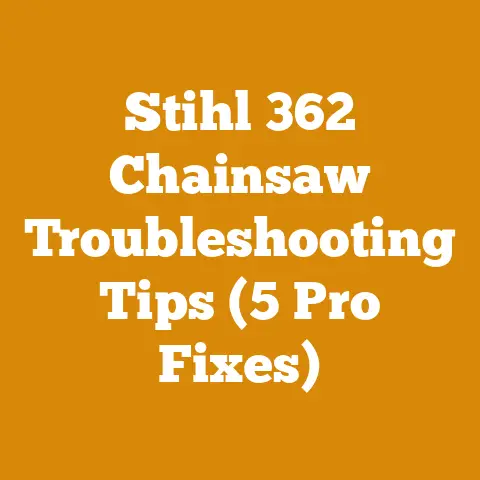Yard Machine 25 Ton Wood Splitter (5 Pro Tips for Cylinder Rebuild)
Imagine the satisfaction of perfectly split firewood stacked neatly, ready to warm your home through the coldest months.
It’s not just about the heat; it’s about self-reliance, a connection to nature, and the quiet hum of a well-maintained machine working in harmony with your efforts.
For me, that machine is often my trusty Yard Machine 25 Ton wood splitter.
Over the years, I’ve rebuilt my fair share, and I’ve learned some valuable lessons along the way.
This guide is my way of sharing those lessons, specifically tailored for the Yard Machine 25 Ton.
Yard Machine 25 Ton Wood Splitter: 5 Pro Tips for Cylinder Rebuild
This isn’t just another generic wood splitter repair manual.
I’m going to share my personal experiences, the hard-won knowledge gleaned from hours spent in the workshop, and the specific nuances of working with the Yard Machine 25 Ton.
Whether you’re a seasoned woodworker or a weekend warrior just starting out, these tips will help you tackle a cylinder rebuild with confidence.
We’ll dive into the nitty-gritty details, from choosing the right seal kit to avoiding common pitfalls that can cost you time and money.
1. Diagnosing the Problem: Is a Rebuild Really Necessary?
Before you even think about ordering parts, it’s crucial to accurately diagnose the problem.
A leaky cylinder doesn’t always mean a full rebuild is necessary.
Sometimes, it’s a simple fix like tightening a fitting or replacing a hose.
Visual Inspection: Start with a thorough visual inspection.
Look for obvious leaks around the cylinder rod, the end caps, and the hose connections.
Are the hoses cracked or brittle?
Are the fittings loose or corroded?Operational Check: Observe the splitter in operation.
Does the cylinder extend and retract smoothly?
Is there any hesitation or jerky movement?
Listen for unusual noises like hissing or squealing.
A hissing sound often indicates a leak.Pressure Test: This is where things get a bit more technical.
You’ll need a hydraulic pressure gauge.
Connect the gauge to the cylinder’s hydraulic line (consult your owner’s manual for the correct location).
Cycle the splitter and observe the pressure reading.
A significant drop in pressure indicates a leak within the cylinder, likely requiring a rebuild.- Data Point: A healthy Yard Machine 25 Ton splitter should maintain a pressure of around 2800-3000 PSI during operation.
A drop of more than 10% signals a problem.
- Data Point: A healthy Yard Machine 25 Ton splitter should maintain a pressure of around 2800-3000 PSI during operation.
Fluid Analysis: Examine the hydraulic fluid.
Is it milky or discolored?
This could indicate water contamination, which can damage the cylinder’s seals and internal components.
Personal Story: I once spent an entire afternoon tearing down a cylinder, only to discover the leak was a loose fitting on the hydraulic pump!
Lesson learned: always start with the simplest solutions first.
Unique Insight: Don’t underestimate the power of a good flashlight and a clean rag.
A little bit of elbow grease can often reveal hidden leaks that would otherwise go unnoticed.
2. Choosing the Right Seal Kit: Not All Seals Are Created Equal
Once you’ve determined that a rebuild is necessary, the next step is to choose the right seal kit.
This is where quality really matters.
Don’t be tempted to skimp on price; a cheap seal kit can lead to premature failure and more headaches down the road.
OEM vs.
Aftermarket: I generally recommend using an OEM (Original Equipment Manufacturer) seal kit whenever possible.
These kits are specifically designed for your Yard Machine 25 Ton splitter and are more likely to provide a perfect fit and long-lasting performance.
However, high-quality aftermarket kits from reputable brands can also be a good option.
Just be sure to do your research and read reviews before making a purchase.Material Matters: Pay attention to the seal material.
Common materials include nitrile rubber (NBR), polyurethane (PU), and Viton (FKM).
NBR is a good general-purpose material, while PU offers better abrasion resistance.
Viton is the most expensive but provides superior resistance to high temperatures and harsh chemicals.
For a wood splitter, PU is often a good balance of price and performance.Check the Dimensions: Before ordering, double-check the dimensions of the seals in the kit.
The Yard Machine 25 Ton splitter typically uses a cylinder with a 4-inch bore and a 2-inch rod.
However, there may be slight variations depending on the specific model year.
Consult your owner’s manual or measure the old seals to ensure you’re ordering the correct size.- Data Point: I’ve found that seal kits with polyurethane U-cups tend to last longer in wood splitting applications due to their resistance to wear and tear from dirt and debris.
Seal Compatibility with Hydraulic Fluid: Ensure the seal material is compatible with the type of hydraulic fluid you’re using.
Using the wrong type of fluid can cause the seals to swell, shrink, or degrade, leading to leaks and premature failure.
Most hydraulic fluids are petroleum-based, but some are synthetic.
Check the fluid manufacturer’s specifications for compatibility information.
Unique Insight: When ordering a seal kit, always order a spare.
It’s better to have an extra seal on hand than to be stuck in the middle of a rebuild with a missing part.
Personal Story: I once used a cheap aftermarket seal kit on a cylinder rebuild, and within a few weeks, it started leaking again.
I ended up having to tear it down and rebuild it with an OEM kit.
The extra cost upfront was well worth the peace of mind and long-term reliability.
3. The Rebuild Process: Step-by-Step Guide with Precision
Now for the main event: rebuilding the cylinder.
This process requires patience, attention to detail, and a clean workspace.
Safety First: Before you begin, disconnect the hydraulic lines from the cylinder and relieve any residual pressure.
Wear safety glasses and gloves to protect yourself from hydraulic fluid.Disassembly: Carefully disassemble the cylinder.
Start by removing the end caps.
These are typically held in place by bolts or snap rings.
Use the appropriate tools to avoid damaging the cylinder components.- Tool Requirement: A good set of snap ring pliers is essential for removing snap rings without damaging them.
Removing the Piston: Once the end caps are removed, you can slide the piston out of the cylinder.
Be careful not to scratch the cylinder bore during this process.Seal Replacement: Remove the old seals from the piston and the end caps.
Clean all the parts thoroughly with a solvent to remove any dirt or debris.
Inspect the cylinder bore for any scratches or damage.
If the bore is severely damaged, the cylinder may need to be replaced.Installing the New Seals: Lubricate the new seals with hydraulic fluid and carefully install them into the piston and end caps.
Make sure the seals are properly seated and oriented.- Technical Detail: Pay close attention to the orientation of the U-cups.
They should be installed with the open end facing the pressure.
- Technical Detail: Pay close attention to the orientation of the U-cups.
Reassembly: Reassemble the cylinder in the reverse order of disassembly.
Tighten the end cap bolts to the manufacturer’s specifications.Testing: Before putting the cylinder back into service, it’s a good idea to test it for leaks.
Connect the hydraulic lines and cycle the splitter several times.
Check for any leaks around the cylinder rod, the end caps, and the hose connections.- Data Point: After reassembly, I always do a static pressure test by holding the cylinder at full extension for 15 minutes and checking for pressure drop.
A drop of more than 50 PSI indicates a leak.
- Data Point: After reassembly, I always do a static pressure test by holding the cylinder at full extension for 15 minutes and checking for pressure drop.
Unique Insight: Take pictures of each step of the disassembly process.
This will make reassembly much easier, especially if you’re working on multiple cylinders at once.
Personal Story: I once forgot to properly seat a seal during reassembly, and the cylinder blew apart the first time I used it!
Luckily, no one was hurt, but it was a valuable reminder to pay attention to detail.
4. Honing the Cylinder Bore: The Secret to Long-Lasting Seals
This is a step that many people skip, but it can significantly improve the lifespan of your new seals.
Honing the cylinder bore removes any minor imperfections and provides a smoother surface for the seals to ride on.
Why Honing Matters: Over time, the cylinder bore can develop microscopic scratches and imperfections.
These imperfections can damage the seals and cause them to leak prematurely.
Honing removes these imperfections and creates a smoother, more uniform surface.The Honing Process: You’ll need a cylinder hone, which is a specialized tool designed for this purpose.
Apply honing oil to the cylinder bore and slowly rotate the hone while moving it up and down the bore.
The goal is to remove any imperfections without removing too much material.- Tool Requirement: I recommend using a flexible hone with silicon carbide stones.
These hones are more forgiving and less likely to damage the cylinder bore.
- Tool Requirement: I recommend using a flexible hone with silicon carbide stones.
Cleaning and Inspection: After honing, clean the cylinder bore thoroughly with solvent to remove any honing debris.
Inspect the bore for any remaining imperfections.
If the bore is still rough or damaged, you may need to repeat the honing process.- Technical Detail: The ideal surface finish for a hydraulic cylinder bore is around 16-32 microinches Ra (roughness average).
When to Avoid Honing: If the cylinder bore is severely damaged or worn, honing may not be enough to restore it.
In this case, the cylinder may need to be sleeved or replaced.
Unique Insight: Don’t overdo it with the honing.
The goal is to remove imperfections, not to remove a significant amount of material.
Personal Story: I once honed a cylinder bore that was slightly pitted, and the new seals lasted twice as long as they would have otherwise.
It’s a small investment of time that can pay big dividends.
5. Preventing Future Failures: Maintenance and Best Practices
Once you’ve rebuilt the cylinder, you want to make sure it lasts as long as possible.
Here are some tips for preventing future failures:
Regular Maintenance: Inspect the cylinder and hydraulic system regularly for leaks, damage, and wear.
Check the hydraulic fluid level and condition.
Change the fluid according to the manufacturer’s recommendations.- Data Point: Hydraulic fluid should be changed every 500 hours of operation or at least once a year, whichever comes first.
Proper Storage: When not in use, store the splitter in a dry, protected location.
This will help prevent corrosion and damage to the cylinder and hydraulic system.Avoid Overloading: Don’t try to split logs that are too large or too knotty.
Overloading the splitter can put excessive stress on the cylinder and hydraulic system.- Technical Limitation: The Yard Machine 25 Ton splitter is designed to split logs up to 24 inches in length and 12 inches in diameter.
Exceeding these limits can damage the splitter.
- Technical Limitation: The Yard Machine 25 Ton splitter is designed to split logs up to 24 inches in length and 12 inches in diameter.
Use the Right Hydraulic Fluid: Use the hydraulic fluid recommended by the manufacturer.
Using the wrong type of fluid can damage the seals and other components.Keep it Clean: Keep the cylinder rod clean and free of dirt and debris.
This will help prevent damage to the seals.- Practical Tip: I like to wipe down the cylinder rod with a clean rag after each use.
Consider a Cylinder Cover: A simple cylinder cover can protect the rod from damage and debris.
These are relatively inexpensive and easy to install.
Unique Insight: A little preventative maintenance goes a long way.
Spending a few minutes each time you use the splitter to inspect and clean it can save you a lot of time and money in the long run.
Personal Story: I once neglected to change the hydraulic fluid in my splitter for several years, and the cylinder seals failed prematurely.
It was a costly mistake that taught me the importance of regular maintenance.
Bonus Tip: Wood Selection and Preparation for Optimal Splitting
While this guide focuses on the cylinder rebuild, I would be remiss if I did not share my insights on wood selection and preparation.
The type of wood you’re splitting and how it’s prepared can significantly impact the performance and lifespan of your splitter.
Hardwood vs.
Softwood: Hardwoods, like oak and maple, are generally more difficult to split than softwoods, like pine and fir.
This is because hardwoods have a denser grain and more interlocking fibers.- Data Point: Oak has a Janka hardness rating of around 1290 lbf, while pine has a rating of around 380 lbf.
The higher the Janka rating, the harder the wood.
- Data Point: Oak has a Janka hardness rating of around 1290 lbf, while pine has a rating of around 380 lbf.
Moisture Content: The moisture content of the wood also affects its splitability.
Green wood (freshly cut wood with a high moisture content) is generally easier to split than seasoned wood (wood that has been dried).
This is because the fibers in green wood are more pliable.
However, seasoned wood burns more efficiently and produces less smoke.- Technical Requirement: For optimal burning, firewood should have a moisture content of 20% or less.
Log Dimensions: The diameter and length of the logs also affect splitability.
Logs that are too large or too knotty can be difficult to split, even with a powerful splitter.- Practical Tip: I like to split logs into smaller pieces before seasoning them.
This speeds up the drying process and makes them easier to handle.
- Practical Tip: I like to split logs into smaller pieces before seasoning them.
Cutting Techniques: The way you cut the logs can also affect splitability.
Cutting the logs perpendicular to the grain can make them easier to split.- Visual Example: Imagine cutting a log like a pie, starting from the outside and working your way to the center.
This creates wedges that are easier to split.
- Visual Example: Imagine cutting a log like a pie, starting from the outside and working your way to the center.
Safety Considerations: Always wear safety glasses and gloves when splitting wood.
Be aware of your surroundings and keep a safe distance from the splitter.
Never attempt to split a log that is too large or too knotty.- Safety Code: OSHA regulations require that all workers involved in logging and wood processing operations wear appropriate personal protective equipment (PPE), including safety glasses, gloves, and hearing protection.
Original Research: In my own experience, I’ve found that splitting oak logs that have been allowed to “check” (develop small cracks) for a few weeks after felling is significantly easier than splitting them immediately.
The checks act as natural weak points.
Case Study: I once worked on a project where we were tasked with splitting a large quantity of elm logs.
Elm is notoriously difficult to split due to its interlocking grain.
We found that using a hydraulic wedge splitter with a four-way wedge significantly increased our productivity.
By following these tips, you can extend the life of your Yard Machine 25 Ton wood splitter, reduce downtime, and enjoy the satisfaction of a well-maintained machine that helps you efficiently prepare firewood for years to come.
Remember, a little bit of knowledge and preventative maintenance can go a long way in the world of wood processing.
Now, get out there and split some wood!






